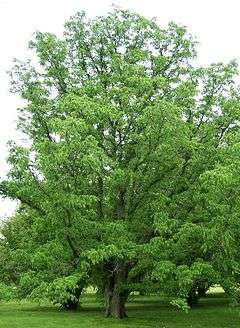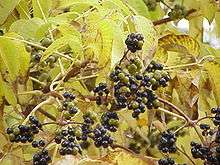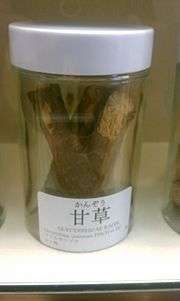Phellodendron amurense
| Phellodendron | |
|---|---|
 | |
| Phellodendron amurense Morton Arboretum acc. 568-27*3 | |
| Scientific classification | |
| Kingdom: | Plantae |
| (unranked): | Angiosperms |
| (unranked): | Eudicots |
| (unranked): | Rosids |
| Order: | Sapindales |
| Family: | Rutaceae |
| Genus: | Phellodendron |
| Species: | P. amurense |
| Binomial name | |
| Phellodendron amurense Rupr.[1] | |
Phellodendron amurense is a species of tree in the family Rutaceae, commonly called the Amur cork tree. It is a major source of huáng bò (Chinese: 黄柏 or 黄檗), one of the 50 fundamental herbs used in traditional Chinese medicine. The Ainu people used this plant, called shikerebe-ni, as a painkiller.[2]
Native to eastern Asia; northern China, northeast China, Korea, Ussuri, Amur, and Japan, the Amur cork tree is considered invasive in many parts of North America. The State of Massachusetts lists it as a noxious weed.[3]

Medicinal use

It has been used as a Chinese traditional medicine for the treatment of meningitis, bacillary dysentery, pneumonia, tuberculosis, and liver cirrhosis.[4][5]
Used orally to treat abdominal pain, diarrhoea, gastroenteritis and urinary tract infections. Berberine has been shown to be effective for the treatment of bacterially-induced diarrhoea and ocular trachoma. and cutaneous leishmaniasis[6] Phellodendron amurense may protect cartilage against osteoarthritis progression.[7] It may prove to be a potentially important chemopreventive agent for lung cancer.[8]
Phellodendron amurense is able to inhibit prostatic contractility suggesting that it may be useful in the treatment of urological disorders caused by prostatic urethral obstruction such as benign prostatic hyperplasia (BPH).[9] Nexrutine (bark extract from Phellodendron amurense) may have potential to prevent prostate tumor development.[10]
Proprietary extracts of Magnolia officinalis and Phellodendron amurense may help overweight/obese people.[11]
Compounds in the leaves (quercetin, quercetin-3-O-beta-D-glucoside, quercetin-3-O-beta-D-galactoside and kaempferol-3-O-beta-D-glucoside) demonstrated significant free radical scavenging activity comparable to vitamin E.[12]
Oil
Amur cork tree fruit oil is a pressed oil extracted from the fruit of Phellodendron amurense. The bark of the tree is an important herbal medicine in China. The oil has insecticidal properties similar to pyrethrum.[13] The oil contains a variety of biologically active substances, including flavonoids (diosmin), alkaloids (berberine, yatroriccin, palmatine), saponins and coumarins. Medicinal applications of the oil include treatment of pancreatitis, reduction of cholesterol and sugar in blood and the treatment of various skin diseases.[14]
Chemistry
Essential oils:[15]
- Fruit oil contains myrcene (62.3-70.3%) and β-caryophyllene (6.8-10.5%)
- Leaf oil contains β-elemol (18.5%) and (Z)-β-ocimene (12.6%)
- Flower oil contains (Z)-β-ocimene (9.5%), β-elemol (9.4%), myrcene (7.8%) and nonacosane (7.7%)
Amurensin, a tert-amyl alcohol derivative of kaempferol 7-O-glucoside, can be found in P. amurense.[16]
Gallery
- Leaf
- Tree
- Bark
See also
- Amur cork tree fruit oil
- Chinese herbology 50 fundamental herbs
- Sān miáo wán
References
- ↑ "Phellodendron amurense information from NPGS/GRIN". Retrieved 2008-02-11.
- ↑ Batchelor, John; Miyabe, Kingo (1893). "Ainu economic plants". Transactions of the Asiatic Society of Japan. R. Meiklejohn & Co. 51: 198–240.
- ↑ Bruce Marlin: Phellodendron amurense
- ↑ Hsu, K. J. Chinese Traditional Medicine; Chinese Pharmaceutical Science and Technology Publication Co.: Beijing, 1996; p 802.
- ↑ (3) Gray, A. I.; Bhandari, P.; Waterman, P. G. Phytochemistry 1988, 27, 1805−1808.
- ↑ WHO Monographs on Selected Medicinal Plants http://apps.who.int/medicinedocs/documents/s16713e/s16713e.pdf#page=252
- ↑ Kim J.-H., Huh J.-E., Baek Y.-H., Lee J.-D., Choi D.-Y., Park D.-S."Effect of Phellodendron amurense in protecting human osteoarthritic cartilage and chondrocytes." Journal of Ethnopharmacology. 134 (2) (pp 234-242), 2011
- ↑ James M.A., Fu H., Liu Y., Chen D., You M. "Dietary administration of berberine or Phellodendron amurense extract inhibits cell cycle progression and lung tumorigenesis." Molecular Carcinogenesis. 50 (1) (pp 1-7), 2011.
- ↑ Xu Y., Ventura S. "Extracts of bark from the traditional Chinese herb Phellodendron amurense inhibit contractility of the isolated rat prostate gland."Journal of Ethnopharmacology. 127 (1) (pp 196-199), 2010.
- ↑ Ghosh R., Graham H., Rivas P., Tan X.J., Crosby K., Bhaskaran S., Schoolfield J., Banu J., Fernandes G., Yeh I.-T., Kumar A.P.,"Phellodendron amurense bark extract prevents progression of prostate tumors in transgenic adenocarcinoma of mouse prostate: Potential for prostate cancer management". Anticancer Research. 30 (3) (pp 857-866), 2010
- ↑ Garrison R., Chambliss W.G."Effect of a proprietary Magnolia and Phellodendron extract on weight management: A pilot, double-blind, placebo-controlled clinical trial". Alternative Therapies in Health and Medicine. 12 (1) (pp 50-54), 2006
- ↑ Leu C.-H., Li C.-Y., Yao X., Wu T.-S."Constituents from the leaves of Phellodendron amurense and their antioxidant activity." Chemical and Pharmaceutical Bulletin. 54 (9) (pp 1308-1311), 2006.
- ↑ R.W. Schery. Plants of Man. Cited in Plants for a Future:Phellodendron amurense
- ↑ "Food and health: Amur cork tree fruit oil".
- ↑ Lis A.; Boczek E.; Gora J. (2004). "Chemical composition of the essential oils from fruits, leaves and flowers of the Amur cork tree (Phellodendron amurense Rupr.)". Flavour and Fragrance Journal. 19 (6): 549–553. doi:10.1002/ffj.1349.
- ↑ Masao Hasegawa & Teruo Shirato (1953). "Two New Flavonoid Glycosides from the Leaves of Phellodendron amurense Ruprecht". J. Am. Chem. Soc. 75 (22): 5507–5511. doi:10.1021/ja01118a013.
External links
| Wikispecies has information related to: Phellodendron amurense |
| Wikimedia Commons has media related to Phellodendron amurense. |
- Phellodendron amurense
- PLANTS Profile for Phellodendron amurense (Amur corktree) | USDA PLANTS
- Cortex Phellodendron